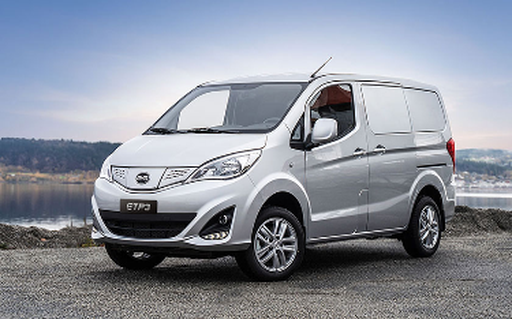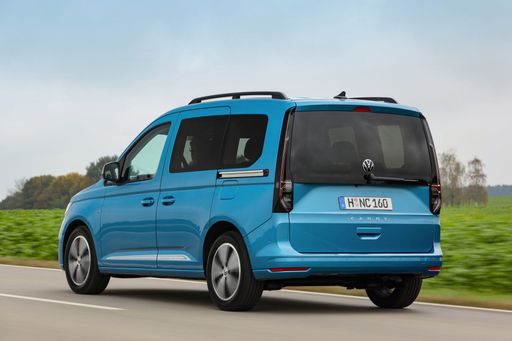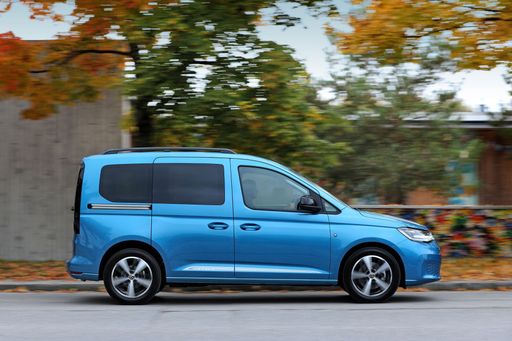BYD ETP3 vs VW Caddy – Differences & prices compared
Compare performance, boot space, consumption and price in one view.
Find out now: which car is the better choice for you – BYD ETP3 or VW Caddy?
The BYD ETP3 (Cargo Van) comes with a Electric engine and Automatic transmission. In comparison, the VW Caddy (High Roof Estate) features a Petrol, Diesel or Plugin Hybrid engine with Manuel or Automatic transmission.
When it comes to boot capacity, the BYD ETP3 offers , while the VW Caddy provides – depending on how much space you need. If you’re looking for more power, decide whether the 136 HP of the BYD ETP3 or the 150 HP of the VW Caddy suits your needs better.
In terms of consumption, the values are per 100 km for the BYD ETP3, and 0.50 L for the VW Caddy.
Price-wise, the BYD ETP3 starts at 31600 £, while the VW Caddy is available from 27800 £. Compare all the details and find out which model fits your lifestyle best!
BYD ETP3
The BYD ETP3 is a versatile electric van that seamlessly blends functionality with environmental consciousness. Its modern design is complemented by a spacious interior, making it ideal for both urban deliveries and day-to-day personal use. Advanced technology features ensure a smooth and efficient driving experience, setting a new standard in the electric vehicle market.
details @ press.bydauto.be
@ press.bydauto.be
VW Caddy
The VW Nutzfahrzeuge Caddy Hochdach-Kombi is a versatile choice for those seeking extra space and practicality in their everyday vehicle. With its functional high roof and adaptable interior, it easily accommodates both passengers and cargo. The Caddy also stands out with its modern design and features aimed at providing comfort and convenience on the road.
details @ vwpress
@ vwpress
 @ vwpress
@ vwpress
 @ vwpress
@ vwpress
 @ vwpress
@ vwpress

|

|
|
|
|
Costs and Consumption |
|
|---|---|
|
Price
31600 £
|
Price
27800 - 45900 £
|
|
Consumption L/100km
-
|
Consumption L/100km
0.5 - 6.9 L
|
|
Consumption kWh/100km
-
|
Consumption kWh/100km
-
|
|
Electric Range
233 km
|
Electric Range
116 - 121 km
|
|
Battery Capacity
-
|
Battery Capacity
19.70 kWh
|
|
co2
0 g/km
|
co2
10 - 165 g/km
|
|
Fuel tank capacity
-
|
Fuel tank capacity
50 L
|
Dimensions and Body |
|
|---|---|
|
Body Type
Cargo Van
|
Body Type
High Roof Estate
|
|
Seats
2
|
Seats
5 - 7
|
|
Doors
5
|
Doors
5
|
|
Curb weight
1640 kg
|
Curb weight
1575 - 1998 kg
|
|
Trunk capacity
-
|
Trunk capacity
-
|
|
Length
4460 mm
|
Length
4500 - 4853 mm
|
|
Width
1720 mm
|
Width
1855 mm
|
|
Height
1875 mm
|
Height
1819 - 1860 mm
|
|
Payload
780 kg
|
Payload
501 - 710 kg
|
Engine and Performance |
|
|---|---|
|
Engine Type
Electric
|
Engine Type
Petrol, Diesel, Plugin Hybrid
|
|
Transmission
Automatic
|
Transmission
Manuel, Automatic
|
|
Transmission Detail
-
|
Transmission Detail
Manual Gearbox, Dual-Clutch Automatic
|
|
Drive Type
Rear-Wheel Drive
|
Drive Type
Front-Wheel Drive, All-Wheel Drive
|
|
Power HP
136 HP
|
Power HP
102 - 150 HP
|
|
Acceleration 0-100km/h
-
|
Acceleration 0-100km/h
11.4 - 14 s
|
|
Max Speed
100 km/h
|
Max Speed
173 - 186 km/h
|
|
Torque
180 Nm
|
Torque
220 - 320 Nm
|
|
Number of Cylinders
-
|
Number of Cylinders
4
|
|
Power kW
100 kW
|
Power kW
75 - 110 kW
|
|
Engine capacity
-
|
Engine capacity
1498 - 1968 cm3
|
General |
|
|---|---|
|
Model Year
2023
|
Model Year
2024
|
|
CO2 Efficiency Class
A
|
CO2 Efficiency Class
E, F, B
|
|
Brand
BYD
|
Brand
VW
|
BYD ETP3
A Revolution in Electric Transport: The BYD ETP3
The BYD ETP3, a breakthrough in the realm of electric light-commercial vehicles, epitomises innovation and efficiency. As a trailblazer from the Chinese automotive giant BYD, the ETP3 is designed to redefine the electric vehicle (EV) market, blending practicality with cutting-edge technology. This article delves into the technical details and groundbreaking innovations that make the BYD ETP3 an intriguing contender in the field of green transportation.
Powertrain and Performance: Setting New Standards
At the heart of the BYD ETP3 lies an electric motor delivering an impressive 136 PS (100 kW), with a rear-wheel drive configuration that ensures a robust performance. This setup promises a seamless driving experience augmented by a torque of 180 Nm, rendering the ETP3 adept at handling the rigorous demands of logistics and commercial tasks.
The vehicle's 233 km electric range reaffirms its position as a practical and efficient choice for city-based transport, reducing the need for frequent charging stops and enhancing productivity. The maximum speed of 100 km/h ensures the ETP3 remains steady and safe on urban roadways.
Innovative Design and Practicality
The BYD ETP3, while primarily focused on functionality, does not compromise on aesthetics. The sleek exterior, extending to 4,460 mm in length, 1,720 mm in width, and 1,875 mm in height, is thoughtfully designed to maximise both aerodynamic efficiency and load space. With a generous payload capacity of 780 kg, the ETP3 is poised to meet the diverse needs of urban businesses and tradespeople.
Built on a foundation of innovation, the vehicle employs a reduction gearbox to ensure smooth transitions, enhancing the overall driving experience. This technological innovation positions the ETP3 as an easy-to-handle and responsive option for urban and suburban environments.
A Commitment to Sustainability
One of the standout features of the BYD ETP3 is its commitment to environmental sustainability. With a CO2 emission rating of 0 g/km, it represents a significant step forward in reducing the carbon footprint of commercial vehicles. This remarkable achievement is complemented by its CO2 efficiency class rating of A, making it not only a financially savvy option in terms of operational costs but also an environmentally responsible choice.
The Comfort Line: Meeting Everyday Needs
The ETP3 comes equipped with the 'Comfort' trim, manifesting in a range of features designed to enhance user experience. With room for two seats, this vehicle balances free space for cargo with driver and passenger needs, ensuring comfort without compromising functionality.
Conclusion: BYD ETP3 - A Glimpse into the Future
The BYD ETP3 emerges as a frontrunner in the electric van market, combining efficiency, sustainability, and practical design. Its array of thoughtful innovations and technical specifications render it highly appealing for any business prioritising eco-friendly transport solutions. As the automotive industry continues to evolve, the ETP3 remains at the forefront, representing the future of logistics and urban transport.
VW Caddy
A Versatile Classic Reimagined: The Volkswagen Caddy
The Volkswagen Caddy has long been celebrated as a versatile workhorse, adeptly bridging the gap between utility and comfort. With its roots tracing back to the 1980s, the Caddy has evolved considerably, transforming from a humble commercial vehicle to a sophisticated multi-purpose van. The latest model continues this tradition by offering innovative features and enhanced technical specifications, reaffirming its status as an indispensable vehicle for both professional and personal use.
Efficient Engines and Environmental Innovation
At the heart of the Volkswagen Caddy lies an array of engines designed to balance performance with efficiency. The latest generation offers a selection of TSI petrol and TDI diesel engines, each engineered to meet the strictest environmental standards. These Euro 6 compliant engines not only reduce emissions but also ensure optimal fuel efficiency, making the Caddy an economically viable choice for businesses and environmentally conscious drivers alike.
For those seeking an even greener option, Volkswagen offers a natural gas engine variant. This innovative powertrain reduces CO2 emissions significantly, yet delivers a driving experience that remains characteristically smooth and powerful. This commitment to alternative energy sources reflects Volkswagen's dedication to sustainability and forward-thinking automotive design.
Advanced Connectivity and Safety Features
The Volkswagen Caddy is not just about robust performance; it also shines in the realm of technology and safety. The modern dashboard is equipped with the Discover Media navigation system, integrating satellite navigation with real-time traffic updates. This intuitive infotainment system gets wirelessly connected to smartphones via Apple CarPlay and Android Auto, keeping drivers informed and entertained during every journey.
Safety is paramount in the latest Caddy, which comes standard with a suite of advanced driver assistance systems. Front Assist with City Emergency Braking ensures crucial safety in urban environments, while Adaptive Cruise Control with speed limiter provides comfort and control on the open road. Additionally, features like the Park Assist system make maneuvering in tight spaces a breeze, offering peace of mind and ease of use no matter the driving conditions.
Dynamic Design and Practicality
Blending aesthetics with functionality, the redesigned exterior of the Volkswagen Caddy is both modern and practical. It features a streamlined silhouette that not only improves aerodynamic efficiency but also enhances its visual appeal. From the distinctive front grille to the LED headlamps, every design element serves a purpose, resonating Volkswagen’s design philosophy of form following function.
Inside, the Caddy offers a remarkably spacious interior, adaptable to a variety of needs. Depending on the configuration, it accommodates up to seven passengers comfortably or can be transformed to offer substantial cargo space, catering to professionals who require versatility from their vehicles. The interior details are thoughtfully crafted, with high-quality materials that sustain durability and comfort over long-term use.
Conclusion: A Modern Mainstay
The Volkswagen Caddy, with its latest iteration, continues to embody versatility and innovation. Its efficient powertrains, cutting-edge connectivity features, and commitment to safety set new standards in the compact van segment. Whether utilized as a family vehicle or a business asset, the Caddy remains a formidable choice, carrying forward a legacy of reliability and ingenuity.
For drivers seeking a well-rounded vehicle that offers the best of both worlds—commercial reliability with personal comfort—the Volkswagen Caddy stands as an exemplary choice. It is not just a vehicle; it's a partner on wheels, designed for the multifaceted demands of modern life.
Which drive types are available for the BYD ETP3?
Available as Rear-Wheel Drive.
The prices and data displayed are estimates based on German list prices and may vary by country. This information is not legally binding.
